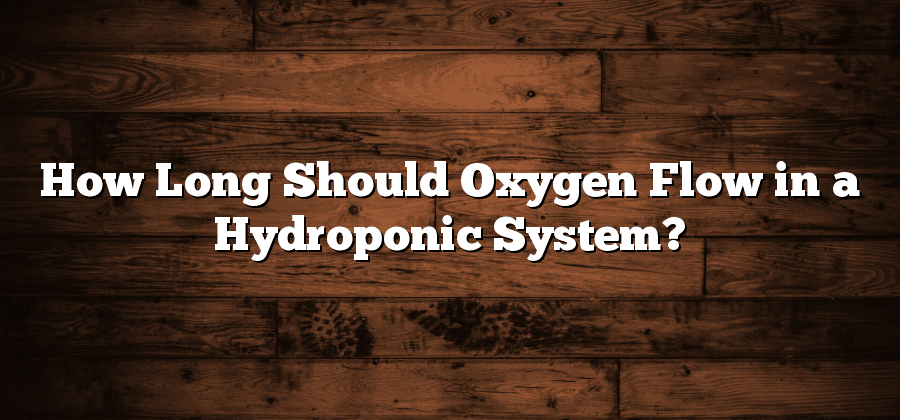Importance of oxygen flow in hydroponic systems
Hydroponic systems have gained significant popularity in recent years due to their ability to provide a controlled environment for efficient plant growth. One of the crucial factors that contribute to the success of hydroponics is the proper flow of oxygen throughout the system.
Oxygen is essential for the respiration process in plants, enabling them to convert sugars and produce energy for growth and development. In a hydroponic system, where plants rely solely on nutrient-rich solutions instead of soil, the availability of oxygen becomes even more critical. Adequate oxygen flow promotes root health, nutrient uptake, and overall plant vigor. Without proper oxygenation, plants can suffocate, leading to reduced growth, wilting, and even death.
Factors affecting oxygenation in hydroponic systems
One of the key factors that can significantly affect the oxygenation in hydroponic systems is the water temperature. Higher water temperatures tend to hold less dissolved oxygen, which can lead to oxygen deficiencies for the plants. It is important to maintain the water temperature within the optimal range to ensure adequate oxygen levels for the hydroponic plants.
Another factor that plays a crucial role in oxygenation is the water movement or circulation. Proper water circulation helps in the exchange of gases, allowing oxygen to dissolve and distribute evenly throughout the system. Insufficient water movement may result in stagnant areas where oxygen levels can drop, negatively impacting plant growth. Thus, it is essential to design the hydroponic system to promote efficient water circulation and oxygenation.
Effects of inadequate oxygen flow in hydroponic systems
Inadequate oxygen flow in hydroponic systems can have detrimental effects on plant growth and overall system health. Without sufficient oxygen, plant roots may become deprived of the necessary oxygen for respiration, leading to reduced nutrient absorption and impaired metabolic processes. As a result, plants may experience stunted growth, yellowing leaves, and increased susceptibility to diseases and pests.
Furthermore, inadequate oxygenation can also create an environment conducive to the growth of harmful microorganisms. These microorganisms can thrive in low oxygen conditions and cause root rot, which can quickly spread throughout the entire hydroponic system. Root rot not only damages the roots, but it also disrupts the plant’s ability to uptake nutrients, resulting in nutrient deficiencies and an overall decline in plant health. Therefore, maintaining proper oxygen levels in a hydroponic system is crucial for ensuring optimal plant growth and preventing the occurrence of these detrimental effects.
Optimal oxygen levels for hydroponic plant growth
Hydroponic systems provide a controlled environment for plant growth, enabling growers to optimize various factors to enhance plant health and productivity. One of the critical factors that significantly impact plant growth in hydroponic systems is the oxygen levels in the nutrient solution. Adequate oxygen supply is essential for the roots’ respiration, as it allows the plants to utilize nutrients effectively and thrive.
Maintaining optimal oxygen levels in the hydroponic system is crucial to maximize plant growth. When the oxygen levels are too low, plants may experience root rot, reduced nutrient absorption, stunted growth, and a weakened immune system. On the other hand, if the oxygen levels are too high, it can lead to oxygen toxicity, causing damage to the roots. Therefore, finding the right balance of oxygen in the hydroponic system is crucial for achieving optimal plant growth and overall system performance.
Different methods to ensure proper oxygenation in hydroponic systems
To ensure proper oxygenation in hydroponic systems, various methods can be employed. One commonly used method is the use of air pumps and air stones. These devices work together to introduce oxygen into the water, promoting a healthy flow of oxygen to the plant roots. The air pump pushes air through the air stones, creating small bubbles that increase the surface area of contact between the air and water. This enhances the oxygen exchange process, allowing the plants to absorb the oxygen they need for optimal growth. By strategically placing the air stones in different areas of the hydroponic system, growers can ensure that every part of the root system receives an adequate supply of oxygen.
Another effective method is the implementation of oxygen-enhancing additives. These additives are specifically designed to increase the oxygen levels in the hydroponic solution. They come in various forms, such as hydrogen peroxide or specialized oxygen supplements. When added to the nutrient solution, these additives release oxygen molecules, enriching the water with dissolved oxygen. This helps to mitigate any potential oxygen deficiencies and keeps the plants healthy and thriving. Additionally, oxygen-enhancing additives can also help prevent the growth of harmful microorganisms, further promoting a healthier hydroponic environment.






